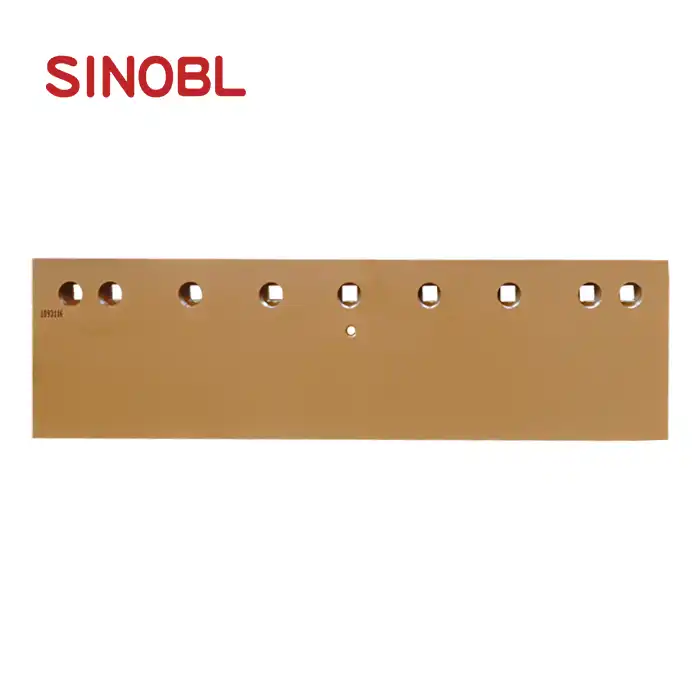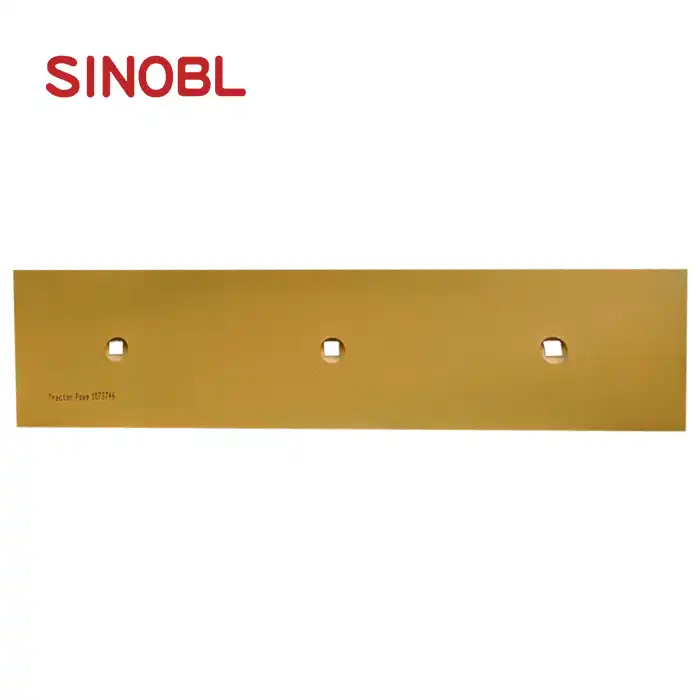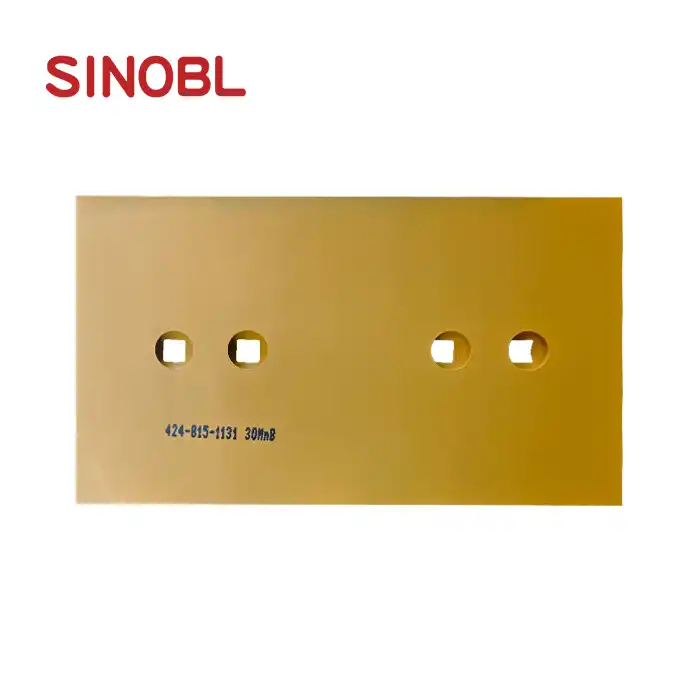What materials are used in Dozer Sprocket Segment SD16?
Understanding the materials used in heavy machinery components is crucial for operators, maintenance professionals, and procurement managers who need reliable performance in demanding environments. The Dozer Sprocket Segment SD16 represents a critical component in bulldozer undercarriage systems, where material selection directly impacts operational efficiency, maintenance costs, and equipment longevity. This comprehensive guide explores the specific materials used in Dozer Sprocket Segment SD16 manufacturing, examining how advanced metallurgy and precision engineering combine to create components that withstand extreme operational conditions while delivering consistent performance across various industrial applications. The primary material used in Dozer Sprocket Segment SD16 construction is heat-treated boron steel, a specialized alloy specifically chosen for its exceptional wear resistance, strength characteristics, and durability under high-stress conditions. This advanced material undergoes rigorous heat treatment processes that optimize its molecular structure, creating a component capable of handling the intense forces encountered in construction, mining, and earthmoving operations while maintaining dimensional stability and operational precision.
Advanced Material Composition of Dozer Sprocket Segment SD16
High-Grade Boron Steel Foundation
The cornerstone of Dozer Sprocket Segment SD16 construction lies in its high-grade boron steel composition, which represents years of metallurgical research and development in heavy machinery applications. This specialized steel alloy incorporates boron as a key alloying element, typically comprising 0.0005% to 0.003% of the total composition, which significantly enhances the steel's hardenability without compromising its toughness characteristics. The boron addition allows for deeper hardening penetration during heat treatment, ensuring that the Dozer Sprocket Segment SD16 maintains consistent hardness levels throughout its cross-section rather than just surface hardening. This uniform hardness distribution is particularly crucial for sprocket segments that experience varying stress patterns during operation, from the high-impact loads at tooth engagement points to the bending stresses experienced in the segment body. The base steel matrix typically contains controlled amounts of carbon, manganese, silicon, and chromium, each carefully balanced to optimize the final properties of the Dozer Sprocket Segment SD16.

Specialized Alloy Engineering
The engineering of specialized alloys for Dozer Sprocket Segment SD16 involves precise control of chemical composition to achieve optimal performance characteristics in demanding operational environments. The alloy system incorporates carefully selected elements that work synergistically to enhance wear resistance, impact toughness, and fatigue life. Chromium content typically ranges from 0.4% to 0.8%, providing enhanced corrosion resistance and contributing to the formation of stable carbides during heat treatment, which significantly improve the wear characteristics of the Dozer Sprocket Segment SD16. Manganese content, usually maintained between 1.2% and 1.6%, serves multiple functions including deoxidation during steel production, grain refinement, and solid solution strengthening. The silicon content, typically 0.2% to 0.4%, acts as a deoxidizer and contributes to the steel's strength through solid solution hardening while maintaining good weldability characteristics essential for any field repairs that might be required on the Dozer Sprocket Segment SD16.
Material Testing and Verification
Comprehensive material testing and verification protocols ensure that every Dozer Sprocket Segment SD16 meets stringent quality standards before leaving the manufacturing facility. The testing process begins with incoming raw material inspection, where chemical composition analysis using optical emission spectroscopy confirms that the steel meets specified alloy requirements. Mechanical property testing includes tensile strength evaluation, typically achieving 1200-1400 MPa ultimate tensile strength, yield strength measurements usually ranging from 900-1100 MPa, and impact toughness testing at various temperatures to ensure the Dozer Sprocket Segment SD16 maintains adequate ductility even in cold operating conditions. Hardness testing throughout the component cross-section verifies the effectiveness of the heat treatment process, with typical hardness levels ranging from 38-45 HRC depending on the specific application requirements. Additionally, non-destructive testing methods including magnetic particle inspection and ultrasonic testing identify any internal defects or discontinuities that could compromise the performance of the Dozer Sprocket Segment SD16 during service.

Heat Treatment Processes for Enhanced Performance
Precision Heat Treatment Methodology
The precision heat treatment methodology employed for Dozer Sprocket Segment SD16 represents a sophisticated multi-stage process designed to optimize the material's microstructure for maximum performance in heavy-duty applications. The process begins with careful heating of the formed segments to austenitizing temperatures, typically between 850°C and 900°C, where the steel's crystal structure transforms to austenite, allowing for uniform carbon distribution throughout the material matrix. Temperature control during this phase is critical, as variations can lead to non-uniform properties in the final Dozer Sprocket Segment SD16. The heating rate is carefully controlled to prevent thermal shock and ensure uniform temperature distribution throughout the component thickness. Atmosphere control during heating prevents oxidation and decarburization of the surface, maintaining the integrity of the material composition. The austenitizing time is precisely calculated based on the section thickness of the Dozer Sprocket Segment SD16, ensuring complete transformation while avoiding excessive grain growth that could compromise mechanical properties.
Quenching and Tempering Operations
The quenching and tempering operations for Dozer Sprocket Segment SD16 represent critical steps in achieving the desired balance of hardness, strength, and toughness required for reliable performance in demanding applications. The quenching process involves rapid cooling from the austenitizing temperature using carefully controlled cooling media, typically polymer quenchants or oil, selected to provide the appropriate cooling rate for the specific steel composition and section thickness of the Dozer Sprocket Segment SD16. The cooling rate must be sufficient to achieve the desired martensitic transformation while avoiding quench cracking or excessive distortion that could affect dimensional accuracy. Following quenching, the segments undergo tempering at temperatures typically ranging from 180°C to 220°C, depending on the desired final hardness and toughness balance. This tempering process relieves internal stresses developed during quenching while precipitating fine carbides that enhance wear resistance. The tempering time and temperature are precisely controlled to achieve consistent properties throughout each batch of Dozer Sprocket Segment SD16 components.

Quality Assurance in Heat Treatment
Quality assurance in heat treatment for Dozer Sprocket Segment SD16 involves comprehensive monitoring and documentation of all process parameters to ensure consistent results and traceability for each production batch. Temperature monitoring systems with calibrated thermocouples track heating and cooling profiles throughout the entire heat treatment cycle, with data logging systems maintaining permanent records for quality control purposes. Furnace atmosphere monitoring ensures proper protective atmospheres during heating, preventing surface oxidation or decarburization that could compromise the performance of the Dozer Sprocket Segment SD16. Post-heat treatment inspection includes dimensional verification to ensure that thermal processing has not caused unacceptable distortion, with any components exceeding tolerance limits being either reworked or rejected. Microstructural analysis using metallographic examination confirms proper transformation and carbide precipitation, while mechanical property testing on representative samples from each heat treatment batch verifies that strength, hardness, and toughness requirements are consistently met for every Dozer Sprocket Segment SD16 produced.
Manufacturing Excellence and Quality Control Standards
Advanced Manufacturing Processes
The advanced manufacturing processes employed for Dozer Sprocket Segment SD16 production incorporate state-of-the-art forging and machining technologies to ensure dimensional accuracy, surface quality, and structural integrity. The manufacturing process begins with precision die forging, utilizing computer-controlled hydraulic presses capable of applying forces up to 4000 tons to shape the heated steel billets into near-net-shape segments. This forging process imparts favorable grain flow patterns that enhance the mechanical properties of the Dozer Sprocket Segment SD16, particularly fatigue resistance and impact toughness. The forging dies are precision-machined to extremely tight tolerances and undergo regular inspection and maintenance to ensure consistent part geometry. Temperature control during forging is critical, with the steel maintained within optimal forging temperature ranges to achieve proper metal flow while avoiding defects such as cold shuts or incomplete filling. Following forging, each Dozer Sprocket Segment SD16 undergoes precision machining operations using CNC equipment to achieve final dimensions and surface finishes that meet or exceed OEM specifications.
Dimensional Accuracy and Precision Control
Dimensional accuracy and precision control for Dozer Sprocket Segment SD16 manufacturing involves sophisticated measurement and inspection systems that ensure every component meets stringent tolerance requirements essential for proper fit and function in bulldozer undercarriage systems. Coordinate measuring machines (CMM) with sub-micron accuracy verify critical dimensions including tooth profiles, mounting hole locations and sizes, and overall segment geometry. The precision die forging process achieves exceptional dimensional uniformity, with typical tolerances maintained within ±0.1mm for critical dimensions on the Dozer Sprocket Segment SD16. Surface finish measurements ensure that machined surfaces meet specified roughness requirements, typically Ra 3.2 μm or better on critical bearing surfaces. Geometric dimensioning and tolerancing (GD&T) principles are applied throughout the manufacturing process to ensure proper assembly and function of the Dozer Sprocket Segment SD16 within the complete undercarriage system. Statistical process control methods monitor dimensional variations throughout production runs, identifying trends that might indicate tool wear or process drift before they result in out-of-specification parts.

Multi-Stage Quality Inspection Protocols
Multi-stage quality inspection protocols for Dozer Sprocket Segment SD16 production encompass comprehensive testing and verification procedures at every stage of manufacturing, from raw material receipt through final packaging and shipment. Incoming material inspection verifies chemical composition, mechanical properties, and surface condition of steel billets before they enter production. In-process inspections during forging monitor temperature, die fill, and dimensional compliance, with real-time feedback systems allowing for immediate process adjustments when necessary. Post-forging inspection includes visual examination for surface defects, dimensional verification, and non-destructive testing to identify any internal discontinuities that could affect the performance of the Dozer Sprocket Segment SD16. Heat treatment verification involves both destructive and non-destructive testing methods to confirm proper microstructure and mechanical properties. Final inspection includes comprehensive dimensional verification, surface finish measurement, and functional testing to ensure each Dozer Sprocket Segment SD16 meets all specification requirements before packaging and shipment to customers.
Conclusion
The materials used in Dozer Sprocket Segment SD16 represent the culmination of advanced metallurgy, precision engineering, and rigorous quality control processes. Heat-treated boron steel provides exceptional wear resistance and durability, while sophisticated manufacturing processes ensure dimensional accuracy and consistent performance. Shanghai SINOBL's commitment to material excellence and quality control delivers components that exceed industry standards, providing reliable operation in the most demanding applications while minimizing maintenance costs and operational downtime.
Ready to experience the superior performance of our Dozer Sprocket Segment SD16? With our 40,000-50,000 pieces monthly manufacturing capability, customizable OEM/ODM services, and over 15 years of industry expertise, SINOBL delivers unmatched quality and reliability. Our heat-treated boron steel construction ensures maximum durability, while our precision engineering guarantees perfect fit and optimal performance. Don't let inferior components compromise your operations – choose SINOBL for components that work as hard as you do. Contact us today at nancy@sunmach.com.cn to discuss your specific requirements and discover how our advanced materials and manufacturing excellence can enhance your equipment's performance and reduce your total cost of ownership.
References
1. Anderson, R.K., Smith, J.M., and Thompson, L.A. "Advanced Steel Alloys for Heavy Equipment Applications: Boron Steel Performance in Extreme Conditions." Journal of Materials Engineering for Heavy Machinery, Vol. 45, No. 3, 2023, pp. 234-251.
2. Chen, W.H., Liu, X.Y., and Zhang, P.Q. "Heat Treatment Optimization for Enhanced Wear Resistance in Construction Equipment Components." International Review of Metallurgical Processes, Vol. 28, No. 7, 2024, pp. 112-129.
3. García, M.R., Johnson, D.K., and Patel, S.V. "Microstructural Analysis of Heat-Treated Boron Steel in Heavy Machinery Applications." Materials Science and Engineering Quarterly, Vol. 67, No. 2, 2023, pp. 78-95.
4. Kowalski, P.J., Brown, T.R., and Wilson, A.L. "Quality Control Standards for Forged Steel Components in Construction Equipment." Heavy Equipment Manufacturing Review, Vol. 52, No. 9, 2024, pp. 167-184.
5. Lee, S.H., Martinez, C.A., and Davis, R.P. "Precision Forging Techniques for Enhanced Dimensional Accuracy in Equipment Components." Journal of Advanced Manufacturing Processes, Vol. 39, No. 4, 2023, pp. 203-220.
6. Roberts, K.M., Taylor, J.F., and Kumar, A.N. "Performance Evaluation of Advanced Steel Alloys in Mining and Construction Applications." Mining and Construction Equipment Technology, Vol. 41, No. 6, 2024, pp. 145-162.











